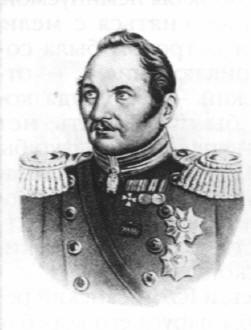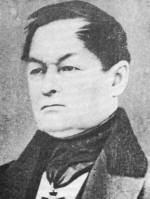Vladimir Kroupnik
“VOSTOK” AND
“MIRNYI” IN
AUSTRALIA
“Vostok” and “Myrnyi” sail off
from Kronshtadt on the 17 July 1819 along with the sister
ships “Otkrytie” and “Blagonamerennyi”. They were to navigate the South Pacific. The sloop
‘Vostok” commanded by the captain-lieutenant Faddey Faddeevich Bellinsgausen
(1778-1852) was launched in 1818 at the Okhta wharf. She had 900 t displacement, was 39.5m long and 10m wide
and armed with 28 cannons. The cargo ship “Mirnyi” commanded by Mikhail Petrovich
Lazarev (1788-1851) was smaller (530t, 36.5x9m, 20 cannons).
The crews consisted of experienced
officers and sailors (all up 189 men), mostly participants of long Pacific
navigations. Among the officers of “Vostok” there were captain-lieutenant
(later admiral) Ivan Zavadovskii, a future Decembrist Constantin Torson,
an astronomer from Kazan Ivan Mikhailovich Simonov (1794-1855) (from 1846
– Head of the Kazan University), an artist Pavel Nikolaevich Mikhailov (1780-1840).
In the crew of “Mirnyi” there were a midshipman Pavel Mikhailovich Novosilskii
and a doctor Nikolay Galkin which left interesting notes about this voyage.
 After a short stay in Rio-de-Janeiro (13-14 November 1819) the ships sail
different routes: “Otkrytie” and “Blagonamerennyi” went towards the Australian
shores around the Southern tip of Africa, and F.F. Bellinsgausen (on
the picture to the left) and M.P. Lazarev led their ships southwards
and, finally, reached the Antarctic coast having left a brilliant record
in the list of great discoveries made by the Russian seafarers and travelers.
When the food and fuel stocks had become depleted on both ships (the prospect
of using empty drums as fuel was even considered), the ships turned north
towards Australia. “Vostok” called in Sydney on the 11 of April 1820 (only
two weeks after the departure of “Otkrytie” and “Blagonamerennyi”). “Mirnyi”
arrived 4 days later. The cheer of the Russian seamen emaciated by the long
and hazardous navigation in the icy waters and Polar night was boundless.
After a short stay in Rio-de-Janeiro (13-14 November 1819) the ships sail
different routes: “Otkrytie” and “Blagonamerennyi” went towards the Australian
shores around the Southern tip of Africa, and F.F. Bellinsgausen (on
the picture to the left) and M.P. Lazarev led their ships southwards
and, finally, reached the Antarctic coast having left a brilliant record
in the list of great discoveries made by the Russian seafarers and travelers.
When the food and fuel stocks had become depleted on both ships (the prospect
of using empty drums as fuel was even considered), the ships turned north
towards Australia. “Vostok” called in Sydney on the 11 of April 1820 (only
two weeks after the departure of “Otkrytie” and “Blagonamerennyi”). “Mirnyi”
arrived 4 days later. The cheer of the Russian seamen emaciated by the long
and hazardous navigation in the icy waters and Polar night was boundless.
Recuperation was the first task of the Russians
since among them there were many who suffered scurvy. Officers and sick sailors
settled in tents on the shore and began to eat a plenty of fruit and drink
lemon juice. A banya was set up in one of the tents – the
first sauna in the Australian history. Pigs and sheep also went ashore –
they got a chance to eat the lush Australian grass.
The ships battered in the Antarctic waters required repairs. It was done
in workshops established on the shore – the hulls, rigging, sails, trodden
copper panels – everything needed maintenance. It is noteworthy that by the
time of the Russian visit the local resources of wood suitable for shipbuilding
had been nearly fully depleted. Ceders fit for production of straight and
durable beams were found almost in the urban area of Sydney near the locality
of the modern famous Sydney bridge.
The Russian seamen were not forgetting about the scientific character of
their expedition as back then the naval power and natural science interlaced
very tightly. They did research in “natural history”, conducted astronomy
and geodetic observations.
This research was led by the astronomer of the expedition I.M. Simonov and
a lieutenant K.P. Torson from “Vostok”. I.M. Simonov, who was only 26 in 1820 was the only professional scientist in the expedition.
The astronomy observation he had been conducting during the whole circumnavigation
became especially important in Port-Jackson as in 1820 there was no full
confidence in the correct definition of the geographical co-ordinates of
Sydney. The data obtained
during the numerous calculations could not be dubious any longer. The importance
of these observations was later pointed out by the European scientists.
"Vostok" and "Mirnyi"
in the Sydney harbor (picture of P.N. Mikhailov)
Among the scientific efforts of
I.M. Simonov in Australia we ought to note
his geological and biological exploration. He also conducted an estimation
of the altitude of the Blue Mountains based on the barometric
measurements of the British engineer Hawkley. The altitude estimated by him
(1234m) was defined quite precisely by the standards of the early XIX century
and turned out to be not very far from the figure known now (1360). The Russian
scientist conducted mineral and soil exploration in the outskirts of Sydney. Based on his observations
I.M. Simonov, as well as F. Shtein, came to the conclusion on the geological
uniformity between Australia and other continents.
“One can conclude, - he wrote, - that the only organic nature depends on
the geographical location in relation to the equator and the ecliptic of
the Earth, rocks and metals occur similarly in all countries on the globe
in a larger or smaller amount depending on the rock type and this amount depends
on the vicinity of some mountains.”
 I.M. Simonov (on the picture to the left) paid significant
attention to the research of flora and fauna of Australia. This part of research
found its reflection in the paintings done by the artist P.N. Mikhailov.
His works have survived till now and are stored in the Russian Museum in St Petersburg and the Museum of History in Moscow. The Mikhailov’s
heritage is well known on the fifth continent and his paintings have been
frequently reproduced in the Australian publications. I.M. Simonov also conducted an ethnographic
research, collected Aboriginal artefacts and the specimens of his collection
still can be seen in the
Russian museums. He socialized with the Aboriginals, and, as he remembered,
“would come unarmed to their meetings” in order to observe the behavior the
“natural inhabitants”. It is noteworthy that based on his observations I.M.
Simonov was one of the first who questioned the origins of the Australian
Aboriginals and spoke out about their kinship with the indigenous population
of the Indian Peninsula. The modern anthropological research confirmed the
relation between the race types of the natives of Australia and some tribes of India and South-East Asia. He left interesting notes about
the social organization of the Aboriginal society and their religious believes.
I.M. Simonov (on the picture to the left) paid significant
attention to the research of flora and fauna of Australia. This part of research
found its reflection in the paintings done by the artist P.N. Mikhailov.
His works have survived till now and are stored in the Russian Museum in St Petersburg and the Museum of History in Moscow. The Mikhailov’s
heritage is well known on the fifth continent and his paintings have been
frequently reproduced in the Australian publications. I.M. Simonov also conducted an ethnographic
research, collected Aboriginal artefacts and the specimens of his collection
still can be seen in the
Russian museums. He socialized with the Aboriginals, and, as he remembered,
“would come unarmed to their meetings” in order to observe the behavior the
“natural inhabitants”. It is noteworthy that based on his observations I.M.
Simonov was one of the first who questioned the origins of the Australian
Aboriginals and spoke out about their kinship with the indigenous population
of the Indian Peninsula. The modern anthropological research confirmed the
relation between the race types of the natives of Australia and some tribes of India and South-East Asia. He left interesting notes about
the social organization of the Aboriginal society and their religious believes.
Despite his favorable attitude towards the Aboriginals I.M. Simonov in his
writings sometimes described them as “ugly savages”, “black semi-demons”
and even as creatures who had “some similarities with orang-outangs”. I.M.
Simonov obviously exaggerated the spread of cannibalism amongst the Aboriginals.
He, as well as some other young Russian seamen coming
to Australia (Al.P. Lazarev, N.D. Shishmarev),
failed to overcome the racial prejudice typical of the Europeans. However, in general, the Russian
seamen behaved impeccably towards the Aboriginals and as the Australian historian
V. Fitzhardinge noted, only the Russians had their reputation unblemished
in relation to their behavior towards the Aboriginals.
The stay in Australia left the warmest
reflections among the Russian seamen. “We have left this nice port not without
a regret. The place where we were received as
the real friends or relatives,” – the captain of “Mirnyi” M.P. Lazarev wrote.
I.M. Simonov was even more emotional in his typical manner: “Our stay in this
wonderful country has remained with us as the best reflection for all life.”
The Australians themselves remember the visit of the Russian ships to Sydney in 1820 as the visit
of the most renown seafarer to their country since
the James Cook’s times.
“Vostok” and “Mirnyi” left Port-Jackson on the 20 (8) May 1820. After the
navigation in Oceania where they found
some previously unknown islands, they returned for rest to Sydney (September-November
1820) before another navigation to the Antarctic
waters.
A.Ya. Massov. Andreevskiy Flag Pod Yuzhnym Krestom. St Petersburg. 1995
E. Govor. Na Mysu Russkikh.
Sydney, Australiada
5, 1995
G. Barrat. The Russians and Australia. Vancouver. 1988
Return
 After a short stay in Rio-de-Janeiro (13-14 November 1819) the ships sail
different routes: “Otkrytie” and “Blagonamerennyi” went towards the Australian
shores around the Southern tip of Africa, and F.F. Bellinsgausen (on
the picture to the left) and M.P. Lazarev led their ships southwards
and, finally, reached the Antarctic coast having left a brilliant record
in the list of great discoveries made by the Russian seafarers and travelers.
When the food and fuel stocks had become depleted on both ships (the prospect
of using empty drums as fuel was even considered), the ships turned north
towards
After a short stay in Rio-de-Janeiro (13-14 November 1819) the ships sail
different routes: “Otkrytie” and “Blagonamerennyi” went towards the Australian
shores around the Southern tip of Africa, and F.F. Bellinsgausen (on
the picture to the left) and M.P. Lazarev led their ships southwards
and, finally, reached the Antarctic coast having left a brilliant record
in the list of great discoveries made by the Russian seafarers and travelers.
When the food and fuel stocks had become depleted on both ships (the prospect
of using empty drums as fuel was even considered), the ships turned north
towards
I.M. Simonov (on the picture to the left) paid significant
attention to the research of flora and fauna of